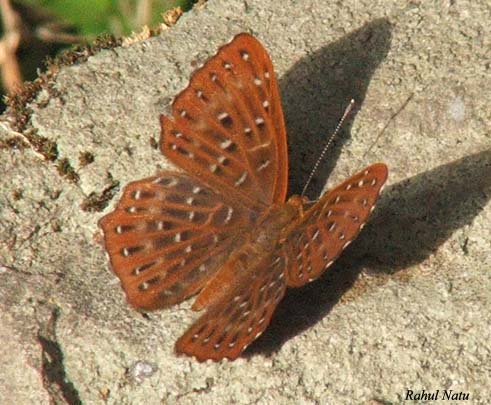- Zemeros flegyas
Taxobox
name = Punchinello

image_width = 240px
regnum =Animal ia
phylum =Arthropod a
classis =Insect a
ordo =Lepidoptera
superfamilia =Papilionoidea
familia =Riodinidae
genus = "Zemeros "
species = "Z. flegyas"
binomial = "Zemeros flegyas"
binomial_authority = (Guerin, 1843)The Punchinello ("Zemeros flegyas") is a smallbutterfly found inSouth Asia andSoutheast Asia that belongs to the Punches and Judies family.Description
:"See glossary for terms used"Like many tropical butterflies they show different wet and dry season forms.
Wet-season form
Male upperside is vinaceous brown, the veins ochraceous brown. Fore and hind wings crossed by four series of minute white spots, the postdiscal series very often obscure, each spot bordered inwardly by a more or less elongate black spot; a terminal very slender black line; cilia alternately black and white. Underside is bright ochraceous brown, the veins conspicuously paler, the white black-bordered spots as on the upperside but larger, more clearly defined and prominent. Antennae brown ringed with white; club black, ochraceous at apex; head, thorax and abdomen concolorous with the wings ; beneath, the palpi, thorax and abdomen slightly paler than the wings.
Dry-season form
Male upperside has the ground colour darker than in the wet-season form; the spots are smaller and duller in colour. On the fore wing the postdiscal series of spots often obsolescent except the spots in interspaces 3, 6 and 8, the latter two very large and prominent; sub-terminal series of spots also often obsolescent. The veins on both fore and hind wings not paler than the ground-colour. Underside is similar to the underside in the wet-season form, but the groundcolour a shade darker; the veins not conspicuously paler; the white spots as in the wet-season form, except the postdiscal and subterminal series on the fore wing, which are as on the upperside, the anterior large white spots of the postdiscal series being very prominent; the inner black bordering to the white spots much smaller than in the wet-season form. Antennae, head, thorax and abdomen as in the wet-season form.
Females have the upper and undersides similar to those of the wet-season form, but the ground-colour brighter and paler; markings also similar, but the black bordering to the white spots less prominent. [Bingham, C. T. 1905. Fauna of British India. Butterflies. Volume 1.]
Larva
Pupa
Gallery
Cited references
Other references
* Evans, W.H. (1932) The Identification of Indian Butterflies. (2nd Ed), Bombay Natural History Society, Mumbai, India
* Wynter-Blyth, M.A. (1957) Butterflies of the Indian Region, Bombay Natural History Society, Mumbai, India.ee also
*
List of Butterflies of India (Riodinidae)
Wikimedia Foundation. 2010.
